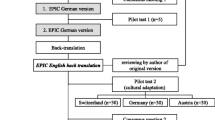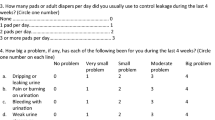Abstract
Background: The Benign Prostatic Hyperplasia-Patient Impact Measure (BPH-PIM®) is a self-reported quality-of-life questionnaire for measuring the impact of urinary/prostate symptoms on the quality of life of patients with BPH. The aim of the present study was to adapt the original instrument to Spanish (for use in Spain) and to assess the psychometric properties of the new version.
Methods: Linguistic adaptation was performed using the standard processes for establishing conceptual equivalence, and was partially conducted in parallel with original instrument development. Psychometric properties were assessed on a sample of 131 patients with BPH who were receiving treatment with doxazosin gastrointestinal therapeutic system (GITS).
Results: All the standardised items had response rates >99%; there were no floor or ceiling effects. Reliability in terms of Cronbach’s a was 0.96 and the intraclass correlation coefficient was 0.97. Construct validity was confirmed by factoranalysis. Convergent validity was confirmed in terms of the relationship to the 12-Item Short-Form Health Survey (SF-12) [p < 0.001], Health Utilities Index Mark III (HUI-3) [p < 0.001] and the International Prostate Symptom Score (IPSS) QOL item (p < 0.001). The instrument showed discriminant validity, in terms of IPSS groups (p < 0.001). The instrument was sensitive to change in terms of the correlation of the domain scores of the PIM to improvements in symptom scores (p < 0.001). Significant differences were observed for those who improved ≥3 points in the IPSS scale (p < 0.001).
Conclusion: A psychometric ally valid and conceptually equivalent version of the BPH-PIM questionnaire has been produced in Spanish to be used in Spain in patients with BPH.




Similar content being viewed by others
References
Barry MJ, Mulley AG, Fowler FJ, et al. Watchful waiting vs immediate transurethral resection for symptomatic prostatism. JAMA 1988; 259: 3010–7
Mebust WK, Bosch R, Ponova J, et al. Symptom evaluation, quality of life and sexuality. In: The 2nd International Consultation on Benign Prostatic Hyperplasia (BPH). Paris, June, 1993; SCI, 1994: 129-43
Barry MJ, Fowler JR, O’Leary MP, et al. The American Urological Association symptom index for benign prostatic hyperplasia. J Urol 1992; 148: 1549–57
Barry MJ, Fowler FJ, O’Leary MP. Correlation of the American Urological Symptom Index with self administrated versions of the Madsen Iversen, Boyarsky and Maine Medical Assessment Program Symptom Indexes. J Urol 1992; 148: 1558–63
O’Connor R. Issues in the measurement of health-related quality of life. Melbourne, Australia: NHMRC National Center for Health Program Evaluation, 1993
Chassany O, Sagnier P, Marquis P, et al. Patient-reported outcomes: the example of health-related quality of life: a European guidance document for the improved integration of health-related quality of life assessment in the drug regulatory process. Drug Inf J 2002; 36: 209–38
Nunnally JC, Bernstein IJ. Teoría Psicométrica. 3a Editión. México: McGraw-Hill, 1995
Fayers PM, Machin D. Quality of life: assessment, analysis and interpretation. Chichester, England: Wiley & Sons, 2000
Roehrborn CG, Abbou CC, Allona-Almagro A, et al. BPH: clinical research criteria. In: Denis L, Griffiths K, Khoury S, et al., editors. Proceedings of The 4th International Consultation on Benign Prostatic Hyperplasia (BPH). Paris, 1997; SCI 1998: 437-514
Lukacs B, Comet D, Grange JC, et al. Construction and validation of a short-form benign prostatic hypertrophy health-related quality-of-life questionnaire. Br J Urol 1997; 80: 722–30
Martin ML, Bushneil DM, Hareendran AV. Psychometric validation of the Benign Prostatic Hyperplasia Patient Impact Measure (BPH-PIM) [abstract no. 1240]. Qual Life Res 2003; 12(7): 826
Denis L, McConnell J, Yoshida O, et al. 4th International Consultation on BPH. Recommendations of the International Scientific Committee: the evaluation and treatment of lower urinary tract symptoms (LUTS) suggestive of benign prostatic obstruction. In: Denis L, Griffiths K, Khoury S, et al., editors. Proceedings of The 4th International Consultation on Benign Prostatic Hyperplasia (BPH). Paris, 1997; SCI 1998: 669-83
Janknegt RA, Chappie CR. Efficacy and safety of the alphal-blocker doxazosin in the treatment of benign prostatic hyperplasia: analysis of 5 studies. Eur Urol 1993; 24: 319–26
Fulton B, Wagstaff AJ, Sorkin EM. Doxazosin: an update of its clinical pharmacology and therapeutic applications in hypertension and benign prostatic hyperplasia. Drugs 1995; 49(2): 295–320
Chung M, Vashi V, Puente J, et al. Clinical pharmacokinetics of doxazosin in a controlled-release gastrointestinal therapeutic system (GITS) formulation. Br J Clin Pharmacol 1999; 48: 678–87
Vela R, Martin JM, Calahorra FJ, et al. Validación cultural y lingüística en castellano del baremo internacional de síntomas prostáticos (I-PSS). Actas Urol Esp 1994; 18(8): 841–7
Ware J, Kosinski M, Keller SD. A 12-item short-form health survey: construction of scales and preliminary test of reliability and validity. Med Care 1996; 34: 220–33
Vilagut G, Ferrer M, Rajmil L, et al. El cuestionario de salud SF-36 español: una década de experiencia y nuevos desarrollos. Gaceta Sanitaria 2005; 19(2): 135–50
Feeny D, Furlong W, Boyle M, et al. Multi-attribute health status classification systems. Health Utilities Index. Pharmacoeconomics 1995; 7(6): 490–502
Ruiz M, Rejas J, Soto J, et al. Adaptación y validación del Health Utilities Index Mark 3 al castellano y baremos de correctión en la población española. Med Clin (Barc) 2003; 120(3): 89–96
Guyatt GH, Feeny DH, Patrick DL. Measuring health-related quality of life. Ann Intern Med 1993; 118: 622–9
Higginson IJ, Carr AJ. Using quality of life measures in the clinical setting. BMJ 2001; 322: 1297–300
Kirby R, Altwein JE, Bartsch G, et al. Results of the PREDICT (Prospective European Doxazosin and Combination Therapy) trial [abstract no. 1028]. J Urol 1999, 161 Suppl. 266
Boyle P, Altwein JE, Bartsch G, et al. Patient perceptions of the effect of medical therapy for benign prostatic hypertrophy (BPH) in the PREDICT trial [abstract no. 1029]. J Urol 1999; 161 Suppl.: 266
Bosch JL, Hop WC, Kirkels WJ, et al. The International Prostate Symptom Score in a community-based simple of men between 55 and 74 years of age: prevalence and correlation of symptoms with age, prostate volume, flow rate and residual urine volume. J Urol 1995; 75: 622–30
Hays RD, Woolley JM. The concept of clinically meaningful difference in health-related quality of life research. Pharmacoeconomics 2000; 18(5): 419–23
Acknowledgements
Two of the authors are employees at Pfizer (Javier Rejas and Asha Hareendran) and the study was funded by an unrestricted grant from Pfizer. The other authors have no conflicts of interest that are directly relevant to the contents of this study.
Members of the Collaborative Group for Spanish Validation of the BPH-PIM® questionnaire (in alphabetical order): M. Esteban (Hospital Príncipe de Asturias, Alcalá de Henares); I. Fernández (Unidad Médica, Pfizer SA, Madrid); F. González (H. Fundación Alcorcón, Alcorcón); A. Hareendran, (Outcomes Research, Pfizer Ltd, Sandwich); F. León (Centro de Salud-Pozuelo Norte, Pozuelo de Alarcón); E. López de la Fuente (Centro de Salud-Castroviejo, Madrid), E. Lledó (H. Fundación Alcorcón, Alcorcón); C. Llorente (H. Fundación Alcorcón, Alcorcón); C. Puig (H. Fundación Alcorcón, Alcorcón); J. Rejas (Outcomes Research, Pfizer SA, Madrid); D. Rengifo (H. Fundación Alcorcón, Alcorcón); M. Ruiz (Universidad Autónoma, Madrid); J.C. Ruiz de la Roja (H. De la Cruz Roja, Madrid); F. Villasante (Centro de Salud-Orcasitas, Madrid).
The Spanish version of the BPH-PIM® can be used for research but permission needs to be obtained from the corresponding author and it should not be translated without permission.
Author information
Authors and Affiliations
Corresponding author
Appendix
Appendix
Spanish version of the BPH-PIM® questionnaire (table V).
Rights and permissions
About this article
Cite this article
Llorente, C., Ruiz, M., Rejas Gutiérrez, J. et al. Linguistic Adaptation and Validation of the Spanish Version of the Benign Prostatic Hyperplasia-Patient Impact Measure (BPH-PIM®). Clin. Drug Investig. 26, 103–112 (2006). https://doi.org/10.2165/00044011-200626020-00005
Published:
Issue Date:
DOI: https://doi.org/10.2165/00044011-200626020-00005





